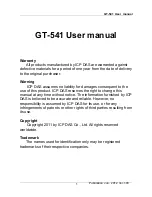
A
Glossary of Terms
194
Routing
Table
A
routing
table
is
a
set
of
rules,
often
viewed
in
table
format,
that
is
used
to
determine
where
data
packets
traveling
over
an
Internet
Protocol
(IP)
network
will
be
directed.
All
IP
‐
enabled
devices,
including
routers
and
switches,
use
routing
tables.
RSA
A
public
‐
key
encryption
and
digital
signature
algorithm,
invented
by
Ron
Rivest,
Adi
Shamir,
and
Leonard
Adleman.
SA
Security
Association.
A
unidirectional
connection
created
for
security
purposes.
All
traffic
traversing
an
SA
is
provided
the
same
security
processing.
In
the
IPsec
context,
an
SA
is
an
Internet
layer
abstraction
implemented
through
the
use
of
an
AH
or
ESP.
It
contains
data
controlling
how
a
transformation
is
applied
to
an
IP
packet.
The
data
is
determined
using
specially
defined
SA
management
mechanisms.
The
data
may
be
a
result
of
an
automated
SA
and
key
negotiation
or
it
may
be
defined
manually.
This
term
is
defined
in
RFC
2401.
SAT
Static
Address
Translation
(SAT).
SAT
is
a
type
of
address
translation
in
which
a
public
IP
address
is
statically
mapped
to
a
private
IP
address.
Dynamic
NAT
is
normally
used
for
outgoing
traffic,
while
SAT
is
used
for
incoming
traffic.
SEG
Security
Gateway.
An
intermediate
system
that
acts
as
the
communications
interface
between
two
networks.
The
internal
sub
networks
and
hosts
served
by
a
security
gateway
are
presumed
to
be
trusted
because
of
shared
local
security
administration.
SHA
A
United
States
standard
for
a
cryptographically
strong
hash
algorithm,
designed
by
National
Security
Agency
(NSA)
and
defined
by
National
Institute
of
Standards
and
Technology
(NIST).
SLB
Server
Load
balancing.
SLB
is
a
mechanism
dealing
with
distributing
the
traffic
load
across
multiple
servers
to
scale
beyond
the
capacity
of
one
single
server,
and
to
tolerate
a
server
failure.
This
technology
is
integrated
in
the
SEG
to
enable
high
performance
and
throughput
of
the
network.
SNTP
Defined
by
RFC
2030,
The
Simple
Network
Time
Protocol
(SNTP)
is
a
lightweight
implementation
of
the
Network
Time
Protocol
(NTP)
described
in
RFC
1305.





































